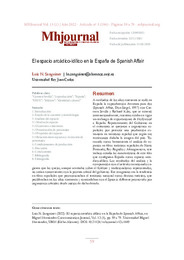Título :
El espacio arcádico-idílico en la España de Spanish Affair |
Autor :
Sanguinet García, Luis N. |
Editor :
Universidad Miguel Hernández de Elche |
Fecha de publicación:
2022-01-31 |
URI :
http://hdl.handle.net/11000/26397 |
Resumen :
A mediados de los años cincuenta se rodó en España la coproducción Aventura para dos (Spanish Affair, Don Siegel, 1957) con Car-men Sevilla y Richard Kiley, que se estrenó internacionalmente, mientras estaba en vigor un embargo de exportaciones de Hollywood a España. Representantes del Gobierno en el extranjero se quejaron a organismos es-pañoles por permitir una producción ex-tranjera en territorio español que según sus testimonios dañaba la imagen del país. To-mando como herramienta el análisis de es-pacios en films turísticos españoles de Nieto Ferrando, Rey-Reguillo y Afinoguenova, este trabajo estudia las características de este film que configuran España como espacio arcá-dico-idílico. Los resultados del análisis y la comparación con el artículo mencionado su-gieren que las quejas, aunque acertadas sobre el folclore y tradicionalismo representados, no serían consecuentes con la postura oficial del gobierno. Ese imaginario era la tendencia en films españoles que promocionaban el territorio nacional como destino turístico, que proliferaban en los años cincuenta y concordaban con el Spain is different promovido por organismos oficiales desde inicios de dicha década
In the mid-1950s, the co-production Spanish Affair (Don Siegel, 1957), star-ring Carmen Sevilla and Richard Kiley, was filmed in Spain and premiered in-ternationally, while a Hollywood exports embargo to Spain was in force. Govern-ment representatives abroad complained to Spanish organizations for allowing a foreign production in Spanish territory, which according to their testimonies dam-aged the country’s image. Taking as a tool the analysis of places in Spanish tourist films by Nieto Ferrando, del Rey Reguillo and Afinoguenova, this paper studies the characteristics of this film that configure Spain as an arcadian-idyllic place. The re-sults of the analysis and the comparison with the aforementioned article suggest that the complaints, although accurate about the folklore and traditionalism represented, would not be consistent with the official position of the government. This imaginary was the trend in Spanish films that promoted the national territory as a tourist destination, which proliferated in the fifties and coincided with the slogan Spain is different promoted by official organizations since the beginning of that decade
|
Palabras clave/Materias:
agenda setting
media shielding
monarchy
Juan Carlos I
television |
Área de conocimiento :
CDU: Ciencias sociales |
Tipo de documento :
info:eu-repo/semantics/article |
Derechos de acceso:
info:eu-repo/semantics/openAccess
Attribution-NonCommercial-NoDerivatives 4.0 Internacional |
DOI :
https://doi.org/10.21134/mhjournal.v13i.1449 |
Publicado en:
Vol. 13 (2022) |
Aparece en las colecciones:
Miguel Hernández Communication Journal Núm.13 (2022)
|
 La licencia se describe como: Atribución-NonComercial-NoDerivada 4.0 Internacional.
La licencia se describe como: Atribución-NonComercial-NoDerivada 4.0 Internacional.
.png)
